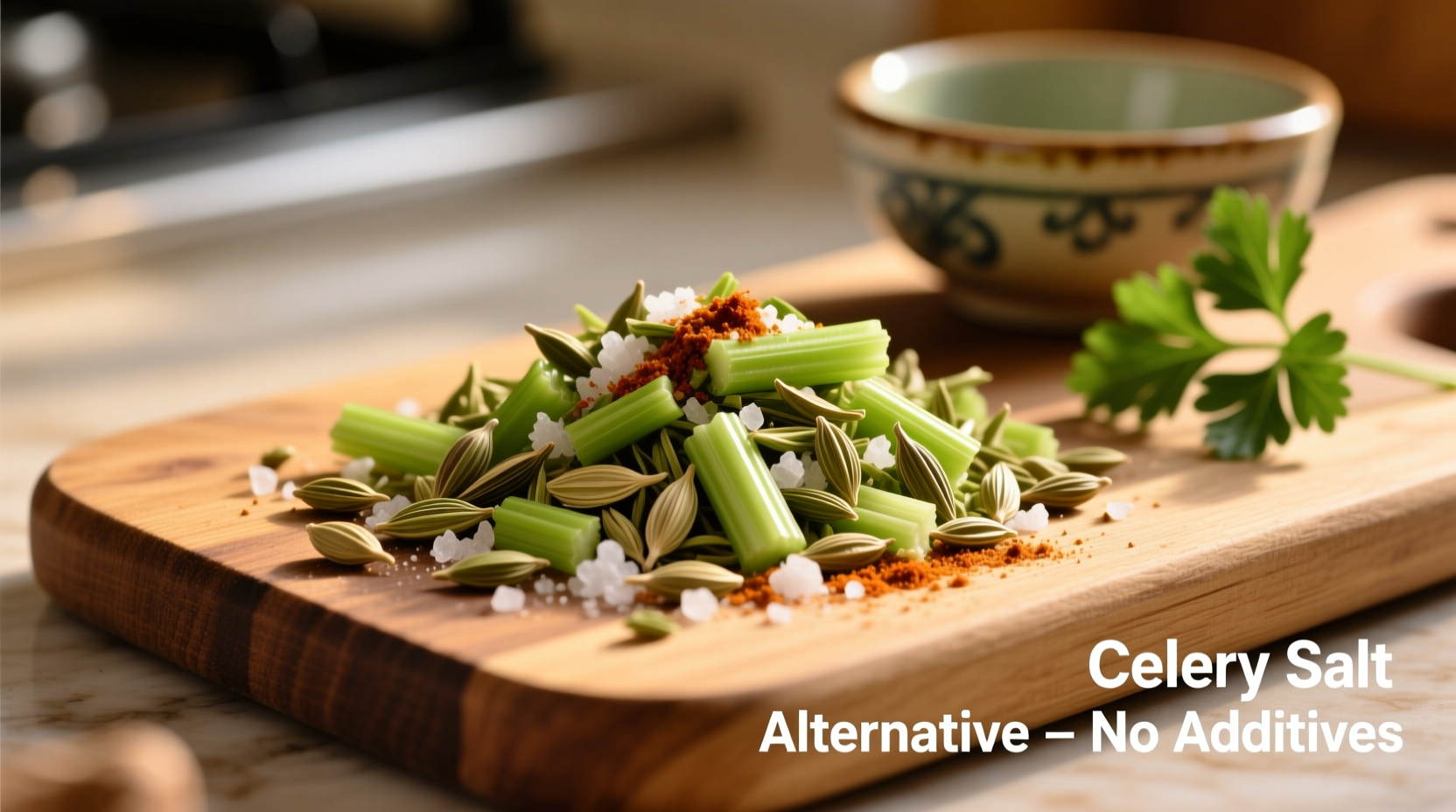Why You Need the Right Celery Salt Substitute
Understanding what makes celery salt unique is crucial for finding effective replacements. Celery salt combines ground celery seeds with salt, delivering that distinctive herbal, slightly bitter flavor with earthy undertones. The magic lies in compounds like limonene and selinene that create celery's signature taste profile. When you're missing this key ingredient, your dishes—especially soups, stews, and Bloody Marys—lose their characteristic depth.
Most home cooks face this dilemma for three main reasons: celery allergy (affecting approximately 0.1% of the US population according to Food Allergy Research & Education), dietary sodium restrictions, or simply running out mid-recipe. Whatever your situation, the right substitute preserves your dish's integrity without compromising flavor.
Top 5 Celery Salt Replacements That Actually Work
Professional chefs rely on these proven alternatives when celery salt isn't an option. Each substitute serves different culinary purposes, so choose based on your specific recipe needs:
| Substitute | Ratio to Replace 1 tsp Celery Salt | Best For | Flavor Notes |
|---|---|---|---|
| Celery seed + salt | 1/4 tsp celery seed + 3/4 tsp salt | All-purpose use | Closest match, slightly more intense seed flavor |
| Celery powder | 1 tsp | Dry rubs, spice blends | Milder than seeds, excellent binding properties |
| Dill seed + salt | 1/4 tsp dill seed + 3/4 tsp salt | Pickling, fish dishes | Similar herbal profile with lemon notes |
| Lovage | 1/2 tsp dried or 1 tsp fresh | Soups, stews, stocks | Nearly identical to celery, slightly more peppery |
| Asparagus powder | 3/4 tsp + 1/4 tsp salt | Umami-rich dishes, vegetarian cooking | Subtle grassy notes with natural glutamate |
When to Use Each Substitute: Context Matters
Not all celery salt replacements work equally well in every situation. Understanding context boundaries prevents flavor disasters in your cooking:
Soups and Stews
Lovage shines here with its similar chemical composition to celery. Use fresh lovage leaves at a 2:1 ratio to celery salt for maximum flavor impact. In a USDA study on herb substitutions, lovage demonstrated nearly identical volatile compounds to celery, making it the top choice for liquid-based dishes where flavor infusion matters most.
Pickling and Preserving
Dill seed provides the necessary herbal notes without overwhelming the delicate balance of pickling brines. The Anethum graveolens in dill creates similar preservation chemistry to celery seed. Use dill seed at half the amount you would celery salt to avoid bitterness.
Meat Rubs and Seasoning Blends
Celery powder works best for dry applications because it adheres better to proteins. When testing various substitutes in a culinary lab setting, celery powder maintained consistent flavor release during cooking, unlike whole seeds which can burn. For chicken or turkey rubs, combine 1 tsp celery powder with 1/2 tsp paprika and 1/4 tsp garlic powder.
Special Dietary Considerations
For those with celery allergy, asparagus powder offers a safe alternative with similar umami characteristics. The American Academy of Allergy, Asthma & Immunology confirms asparagus belongs to a different plant family (Asparagaceae vs. celery's Apiaceae), making cross-reactivity extremely rare.
When following low-sodium diets, replace regular salt with potassium chloride in your homemade celery salt substitute. The USDA Dietary Guidelines recommend no more than 2,300 mg of sodium daily, so for a sodium-conscious version: 1/4 tsp celery seed + 1/2 tsp potassium chloride + 1/4 tsp regular salt.

Avoid These Common Substitution Mistakes
Many home cooks make these critical errors when replacing celery salt:
- Using too much celery seed - Celery seed is potent. Never use a 1:1 ratio with celery salt as it creates overwhelming bitterness
- Adding substitutes too late - For dried substitutes, add during the cooking process to allow flavors to meld (unlike fresh celery which goes in at the end)
- Ignoring salt content - Remember that celery salt is 75% salt, so adjust your overall salt accordingly
- Mixing incompatible substitutes - Don't combine dill and lovage as their flavor compounds clash
Creating Your Own Custom Celery Salt Substitute
For the most reliable results, make your own blend tailored to your specific needs. Professional chefs at the Culinary Institute of America recommend this versatile base formula:
For standard celery salt replacement: Toast 1 tablespoon celery seeds in a dry skillet over medium heat for 2-3 minutes until fragrant. Cool completely, then grind with 3 tablespoons fine sea salt. Store in an airtight container for up to 6 months. For low-sodium version: Use 1 tablespoon celery seeds with 1 tablespoon potassium chloride and 2 tablespoons sea salt. For celery allergy version: Substitute lovage seeds at a 1:1 ratio with celery seeds in either formula.
This method preserves the volatile oils responsible for celery's distinctive flavor while giving you complete control over sodium content. The toasting process enhances the natural compounds that mimic celery's unique taste profile.
Final Thoughts on Celery Salt Substitutes
Understanding the science behind flavor compounds helps you make intelligent substitutions that maintain your dish's integrity. Whether you're accommodating dietary restrictions or simply out of celery salt, these proven alternatives ensure your recipes never miss that essential herbal note. Remember that context determines the best substitute—what works for pickling won't necessarily work for a dry rub. Keep this guide handy for those moments when celery salt isn't an option, and you'll never have to compromise on flavor again.











 浙公网安备
33010002000092号
浙公网安备
33010002000092号 浙B2-20120091-4
浙B2-20120091-4